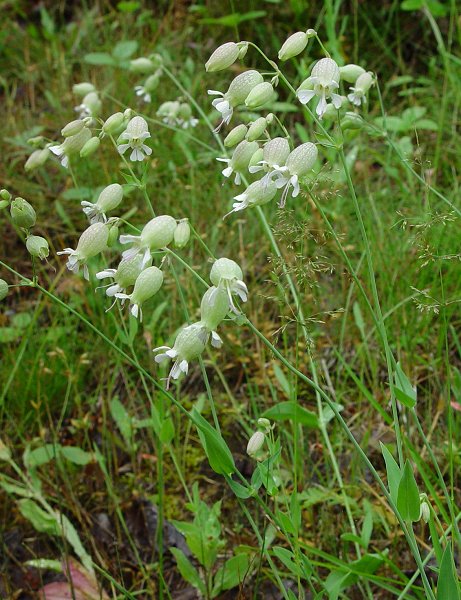Silene vulgaris (Moench) Garcke
Bladder Campion

Introduced
CC = *
CW = 5
MOC = 9
© DETenaglia
Silene vulgaris (Moench) GarckeBladder Campion | |
 |
Introduced CC = * CW = 5 MOC = 9 |
© DETenaglia |
|
Family - Caryophyllaceae Habit - Short-lived perennial forb from a woody rootstock. Stem - Ascending to erect, to 80 cm, sometimes from a spreading base, few-branched toward the base, glabrous or rarely sparsely pubescent with short, downward-curled hairs toward the base, glaucous.
Leaves - Opposite, simple. Basal leaves usually withered or absent at flowering, when present shorter than the largest stem leaves, short-petiolate or sessile. Stem leaves opposite, sessile. Leaf blades 2-6 cm long, oblong or broadly elliptic to narrowly lanceolate, tapered at the base (basal leaves) or somewhat clasping (most stem leaves) tapered to a sharply pointed tip, the surfaces glabrous, usually somewhat glaucous.
Inflorescences - Open terminal clusters or panicles, the stalks 0.5-2.0 cm long, glabrous, the bracts paired and resembling small leaves, with herbaceous, green margins.
Flowers - Flowers perfect. Sepals 11-15 mm long, the tube with many faint parallel and anastomosing nerves, narrowly bell-shaped at flowering, becoming inflated and papery at fruiting, ascending to somewhat spreading at the tip and not tightly enclosing the fruit, light green to pale green or purplish-tinged, not paler between the nerves, glabrous, umbilicate at the base, the 5 lobes broadly triangular, green or purplish-tinged, sharply pointed at the tip, the margins herbaceous and green at flowering, similar in texture to the rest of the calyx at fruiting. Petals 5, 14-19 mm long, the expanded portion 4-7 mm long, entire to 2-lobed at the tip, white, with a pair of small appendages on the upper surface at the base of the expanded portion. Stamens 10. Styles 3.
Fruits - Capsules 6-9 mm long, dehiscing apically by 6 teeth, with a stalklike basal portion 2-3 mm long. Seeds 1.0-1.5 mm wide, kidney-shaped, the surface finely tuberculate, black.
Flowering - May - August. Habitat - Forests, fields, railroads, roadsides, open, disturbed areas. Origin - Native to Europe. Lookalikes - Silene csereii. Other info. - This weedy but striking species can be found scattered throughout Missouri but is infrequent. It occurs in most states of the continental U.S., most commonly in northern regions, and where present can be abundant. This species can be identified by its glabrous and glaucous stems, its opposite entire leaves, and its much inflated calyces. In appearance it is similar to S. csereii, but that species has smaller calyces which lack the conspicuous reticulate venation of the Silene vulgaris calyces. Photographs taken at Pictured Rocks National Seashore, MI., 7-22-02 (DETenaglia); also near Goodrich, Genesee County, MI, 7-3-2023, near Hodenpyl Dam scenic turnout, Wexford County, MI, 7-6-2023, and at Sleeping Bear Dunes, Leelanau County, MI, 7-6-2023 (SRTurner). |